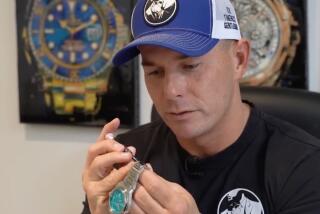Collector Has Time on His Hands
- Share via
SIMI VALLEY — Richard Chapple opens a briefcase lined with foam and carefully shows off a few of his aged treasures.
He picks up the silver dollar-sized pocket watches one at a time, noting how they were the standard in timekeeping long before Timex, Casio or Swatch.
Americans marked the hours with the help of U.S. watchmakers with names such as Elgin, Hamilton and Tremont.
And for nearly 100 years, these companies were considered world leaders in making timepieces, employing skilled artisans who built pocket watches so dependable that many are still ticking today.
That’s what makes these collectibles so precious, said Chapple, who owns a telecommunications company in Simi Valley.
The 64-year-old thinks of himself as something of a treasure hunter, always on the lookout for another aging watch of value to add to his 500-piece collection, the worth of which he estimates at $200,000.
During a free moment in his third-floor office, Chapple turns a small, 14-karat gold watch in his hand. He opens the back with a tiny tool and shows off its workings, which are made of gold and other metals.
He bought this 1896 Elgin last year for $500 from a clock dealer in rural North Carolina; it’s now worth more than $1,000.
“Those are the good ones, when you get [a watch and] they don’t know about” its true value, he said.
Among Chapple’s finds are 12 sterling silver watches manufactured by Tremont, a company that made only about 5,000 watches--all during the Civil War. Collectors believe there are only 1,000 Tremonts left, which means Chapple probably owns one of the largest collections.
Ron Reed, president of the Southern California chapter of Watch and Clock Collectors and a longtime lover of timepieces, said Chapple’s medium-sized collection is impressive.
*
But Reed, a construction company project manager, has known collectors with several thousands of timepieces in their collections.
Some collectors concentrate on specific types of timepieces. Chapple, for example, specializes mostly in American pocket watches made between the mid-1800s and the 1950s.
“The history of clocks and watches is basically the history of the United States, and of the world,” Reed said, adding that the Industrial Revolution would have arrived much more slowly had the masses not known what time they needed to arrive at work.
Chapple began collecting large clocks in 1965, but switched to pocket watches after about 10 years when his wife complained about the constant sound of chimes.
He started his new collection with a pocket watch passed down from his great-grandfather, who purchased the silver Elgin in the 1900s. Chapple said there’s nothing special about that watch, except its memories.
The antique didn’t even work until Chapple found retired Los Angeles jeweler Carl Lowenthal to fix it.
Lowenthal brought the seven-jewel Elgin back to life by dissembling it and building new parts. He also used the opportunity to give Chapple a lesson on watch history, turning him into sort of a timepiece trivia buff.
Chapple was fascinated to learn that when trains began crisscrossing the United States, there were no such things as time zones, and therefore, no consistent schedules. It wreaked havoc on travelers and increased the chances of trains colliding, Chapple said.
A Canadian railway planner and engineer devised a plan for standardizing time in North America in the late 1870s. To monitor this new way of looking at time across great distances, special watches were designed to keep track of the new zones.
*
Some of them--like several that Chapple owns--have engravings of trains on them. But what makes them special is how they were built, Chapple said.
Strict specifications meant these early watches worked well in both extreme heat and cold.
Hamilton made some of the better watches issued to railroad workers and, depending on their condition, the watches can now be worth quite a bit of money, Chapple said.
Chapple owns several of those original railroad Hamiltons and Lowenthal still works on them.
In the back bedroom of his Thousand Oaks home, the 84-year-old jeweler makes by hand most of the parts that keep Chapple’s watches spinning.
Lowenthal uses a special lathe to cut and fit new pieces. Some parts are so small, they would fit on the head of a pin.
He has been repairing watches for more than 60 years, learning the trade from two Swiss watchmakers who worked for his father, also a watch salesman and repairman.
“They could hardly speak any English,” he said of the Swiss employees. “This was back in the 1930s, and boy, those men were really artistic.”
More to Read
Inside the business of entertainment
The Wide Shot brings you news, analysis and insights on everything from streaming wars to production — and what it all means for the future.
You may occasionally receive promotional content from the Los Angeles Times.









